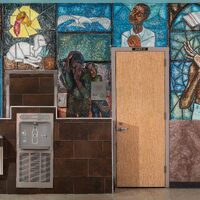Untitled mural by James H. McNeil

James H. McNeil’s Hannah Hall mural mimics the style of stained glass art that commonly appears in churches. The left panel features a shirtless Black man, dressed humbly, in front of a yellow cross. To the right, there is a small panel featuring a glass of wine, which in Christian theology represents the blood of Christ, and a lamb, which is a common symbol for Christ and his sacrifice. The middle panel shows three figures cowering at the bottom, while a dove soars overhead. This may reference the story of Noah’s Ark, in which Noah sends a dove out to search for dry land after a flood sent by God. To the right, a young man, possibly the artist himself, closes his eyes and clasps his hands in prayer. In the rightmost panel, another shirtless Black man holds his hands up to his chest. Behind him is a book and another cross.
McNeil’s mural is one of several religiously-themed murals in Hannah Hall, but it distinguishes itself in a number of ways. For one, McNeil’s mural subverts the usual subject matter of church stained glass. Relatively few churches feature Black people in their stained glass images. In the last few decades, some Black churches have sought to replace stained glass images of fair-skinned or blonde depictions of Jesus, or other white figures, with images that are more representative of their congregations. Further, even fewer churches feature regular people, as opposed to saints or other biblically significant figures, in their stained glasses, marking McNeil’s mural as distinct from the norm in another way. Additionally, alumni who knew Mr. McNeil have said that it was a point of pride for him to have painted the first crucifix in the building. Taken as a whole, this seems to suggest that Christianity was an important part of the artist’s life. McNeil’s mural had become damaged over the years, but was conserved in the last decade and is now in good condition for all to see.
This program is made possible in part by a grant from Humanities Texas, the state affiliate of the National Endowment for the Humanities.
